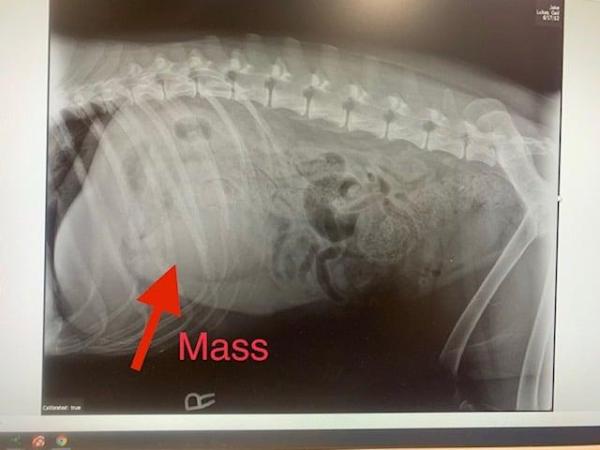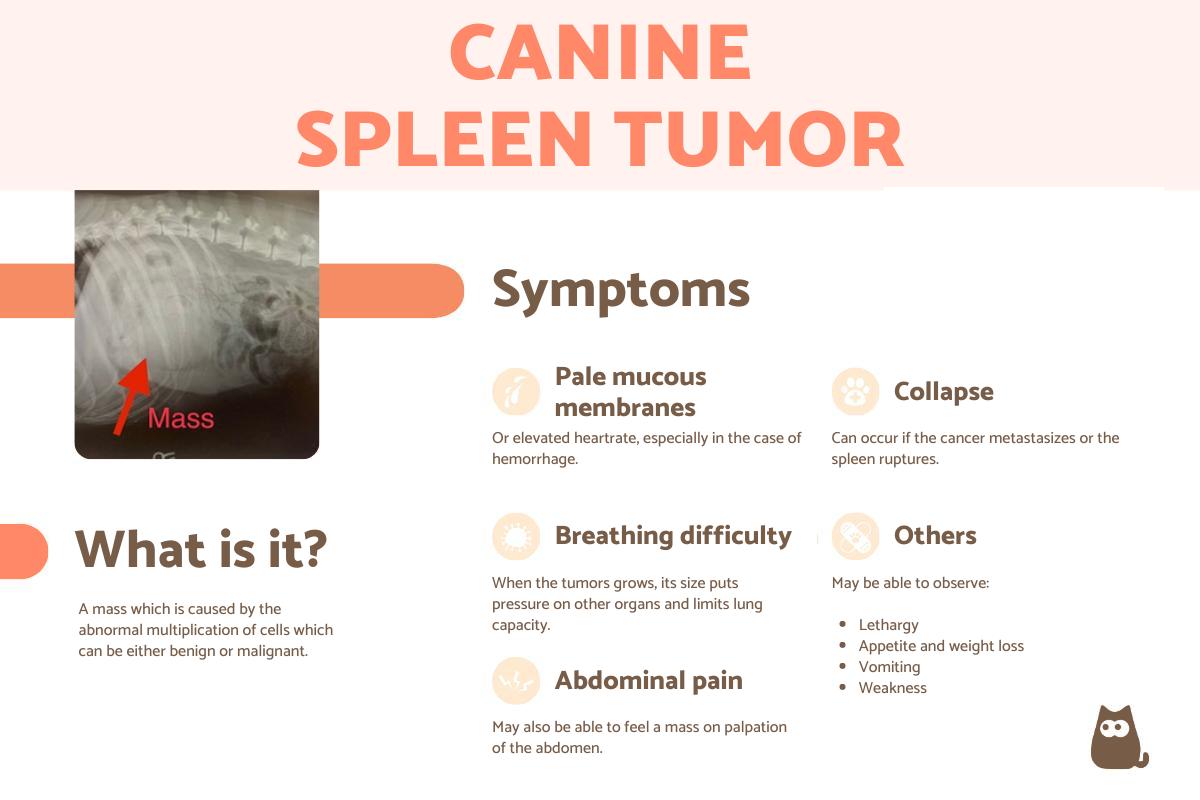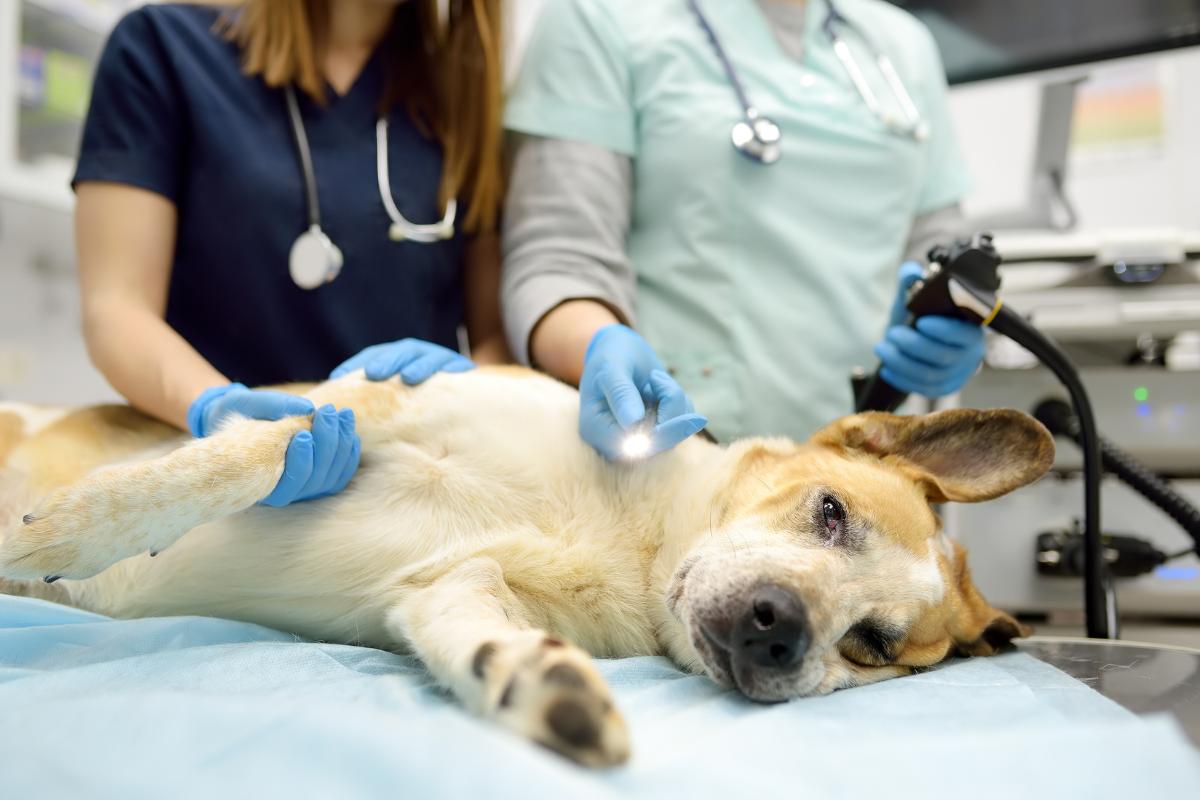Canine Spleen Tumor - Symptoms



See files for Dogs
A splenic tumor in dogs is an abnormal growth on the spleen, a lymphoid organ which plays an important role in the immune system. It can be said to act as a kind of filter for blood, storing platelets, removing old red blood cells and metabolizing hemoglobin. Although a very important organ, it is not considered a vital organ. This is because a dog may be able to live without a spleen, although their health and well-being is at a much greater risk if this were to occur. One reason a dog's spleen may be removed is due to tumors, whether benign or malignant. AnimalWised discovers more about the threat this causes to a dog's health by looking at canine spleen tumor symptoms and treatment.
Types of spleen tumors in dogs
The spleen is a secondary lymphoid organ in dogs, playing a direct role in their immune response. In the spleen, the dog's immune cells mature and defective cells are destroyed or recycled. The recycling of red blood cells involves breaking them down and retaining useful component parts. To decide which cells are stored and which are destroyed, it monitors the blood and filters it accordingly.
For better monitoring, the spleen contains a substance known as white pulp. This is rich in immune cells and helps to detect pathogens in the blood. This is important for the immune response to produce antibodies to fight the pathogen. Despite the spleen being important in fighting disease, it can become diseased itself. When splenic cells multiply and proliferate to a large degree, they can result in a tumor.
Spleen tumors in dogs fall under one of two main categories:
Benign canine spleen tumors
Benign tumors are harmless growths. This is because they do not have the ability to produce metastasis or endanger the life of our dogs. In the canine species, we can find the following benign tumors in the spleen:
- Fibroma: a benign tumor of connective tissue that can sometimes be confused with a malignant tumor due to its solidity, although it is not invasive.
- Lipoma: a benign tumor made up of fat cells. It is characterized by being soft, round and mobile when palpated. Learn more about the symptoms and treatment of lipoma in dogs with our related article.
Malignant canine spleen tumors
Malignant tumors are characterized by being cancerous, invasive and aggressive. They the ability to produce metastases in other locations and put the life of our canine companion at risk. In dogs, the following malignant splenic tumors can be found:
- Hemangiosarcoma: this is the most common type of canine spleen tumor and is very aggressive. It originates in the endothelial cells that line the inside of blood vessels, allowing it to come into contact with blood and spread to other organs.
- Lymphoma: this is a malignant tumor that originates in lymphocytes and can affect various organs, including the spleen.
- Metastatic tumor: in some cases, the spleen may be the site of a metastasis from a primary tumor located in another organ of the dog.
While splenic tumors are internal, you may want to know about the types of lump you can find on your dog which may indicate the presence of a tumor.
Causes of canine spleen tumor
Tumors are usually caused by one or more mutations in the DNA of the cells that cause them. Such mutations lead to uncontrollable cell division. while the underlying cause may be idiopathic, there are several known factors related to the development of tumors in the spleen of dogs. They include the following:
- Genetics: there are breeds that seem to be more predisposed to developing tumors, such as the Golden Retriever, Labrador Retriever and German shepherd.
- Sex: splenic tumors appear to be more common in male dogs.
- Age: tumors are most common in dogs around 10 years of age[1].
- Environmental factors: chronic inflammation, oxidative stress or environmental toxins may predispose to the development of tumors in the spleen or other locations.
Learn about another type of organ tumor in dogs with our article on canine liver cancer symptoms and treatment.
Symptoms of canine spleen tumor
Dogs with splenic tumors often present with nonspecific signs such as:
- Lethargy
- Appetite loss
- Weight loss
- Vomiting
- Weakness
In addition, we may be able to observe the following clinical signs of canine spleen tumors:
- Pale mucous membranes
- Elevated heartrate
- Breathing difficulties
- Swollen abdomen or a palpable mass if the tumor
- Severe abdominal pain or collapse
These symptoms often depend on the size and extent of the the tumor. If a splenic tumor in dogs has grown large enough to press on surrounding organs, it can limit the space for lung expansion and cause breathing difficulties. When sufficiently large, the tumor will be observed as a swollen point in the abdomen. This can lead to severe abdominal pain and, eventually, collapse if the spleen ruptures.

Diagnosis of canine spleen tumor
The first step in diagnosing a splenic tumor in a dog is to perform a thorough general examination and complete medical history. This requires veterinary consultation. In some cases, dogs with splenic tumors present with abdominal distension, bleeding into the peritoneum and hypovolemic shock. They may also be accompanied by signs of coagulopathy, hemorrhages or petechiae.
Blood tests should be performed on dogs if we suspect a splenic tumor. These will assess the presence of anemia, platelet count and general health of the dog.
To complete the diagnosis of a canine spleen tumor, the following imaging tests are used:
- Ultrasound: to assess the condition of the liver and other organs for metastasis.
- X-rays: to detect organ enlargement or possible bleeding.
The last step to confirm the diagnosis of splenic tumor is to perform a cytology or a biopsy. Thee latter is more recommended due to the risk of bleeding associated with the extraction of cells by aspiration in cytology.

Treatment for canine spleen tumor
Treatment for spleen tumors in dogs depends on whether they are benign or malignant, as well as whether there is metastasis in the case of dog spleen cancer:
- Benign tumors: these should be removed surgically, especially if they are large or causing discomfort.
- Malignant tumors: the treatment of choice for malignant tumors is removal of the entire organ, followed by chemotherapy. The latter is almost always recommended. Even if there is no metastasis at the time of splenectomy (spleen removal), it is very likely to appear further down the line.
The most commonly used chemotherapy drugs for canine spleen cancer are cyclophosphamide, doxorubicin and vincristine. Other medications used in the treatment of splenic tumors in dogs include anti-inflammatory drugs, antibiotics and painkillers.
Caring for a dog with a spleen tumor
In caring for a dog affected by a splenic tumor, it is important to know that recovery after the spleen removal operation usually lasts between 15 and 30 days. During this time, the main care is as follows:
- Wound care: prevent your dog from licking or scratching the incision site as this could open the wound and cause secondary infections.
- Check-ups: the dog must be under veterinary supervision and efforts must be made to provide them with the best quality of life in their remaining months. This involves ensuring they feel love and companionship. To the best extent possible, any pain or other symptoms they may experience must be mitigated.

Life expectancy of a dog with a spleen tumor
Malignant spleen tumors in dogs often have a poor prognosis. Even if the organ is removed, the dog is likely to already have metastases. In most cases, this leads to euthanasia within about 6 months if chemotherapy has been administered. This may be reduced to about 2 months if only the spleen has been removed without chemotherapy treatment. If you notice any of the symptoms, go to the vet quickly to get the best possible prognosis.
While malignant tumors are a serious disease affecting the spleen, they are not the only one. Learn more with our article which explains why a dog has an enlarged spleen.
This article is purely informative. AnimalWised does not have the authority to prescribe any veterinary treatment or create a diagnosis. We invite you to take your pet to the veterinarian if they are suffering from any condition or pain.
If you want to read similar articles to Canine Spleen Tumor - Symptoms, we recommend you visit our Degenerative diseases category.
1. Corvera, G., Alegría-Morán, R., Cifuentes, F. F., & Torres, C. G. (2024). Pathological Characterization and Risk Factors of Splenic Nodular Lesions in Dogs (Canis lupus familiaris). Animals : an open access journal from MDPI, 14(5), 802.
https://doi.org/10.3390/ani14050802








